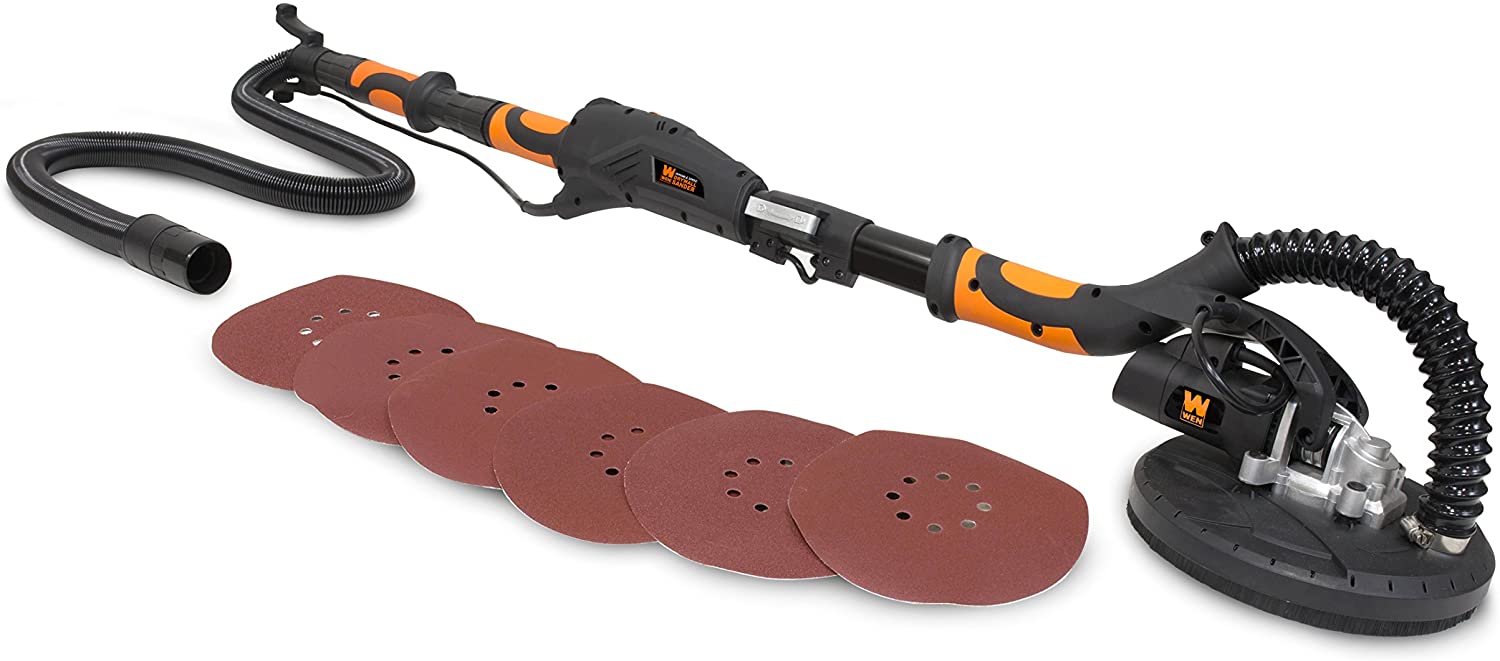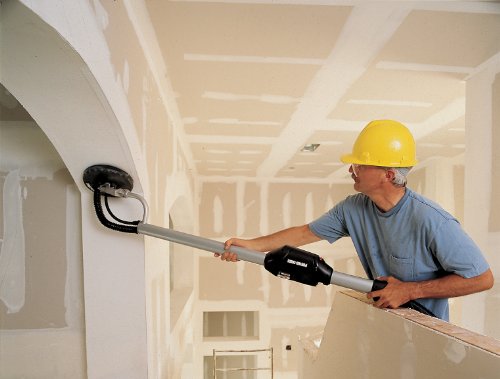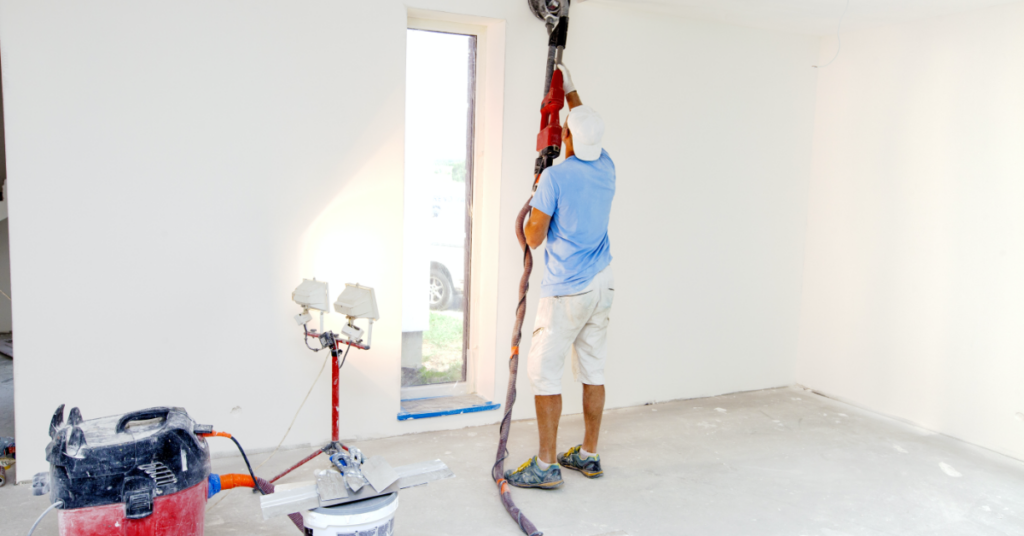Renovating the whole house can be tedious and takes too much of your precious time. Drywalls are quicker to install, and their overall cost is way less as opposed to a solid concrete or brick wall. Adding to it, drywalls have fire-resistant and noise reduction capabilities.
So, if you are planning to get drywalls for your place. Sanding them is an essential thing, next to their proper execution.
Sanding creates a smooth and flat surface for you to color or leave as be. Moreover, sanding helps produce numerous rough surfaces, which aid the pain to adhere to the wall.
At a Glance: Our Top Picks for Sanders For Drywall
- OUR TOP PICK: WEN 6369
- RUNNER-UP: PORTER-CABLE 7800
- BEST BUDGET OPTION: TACKLIFE PDS03A 6.7A
- BEST ELECTRIC SANDER FOR DRYWALL: POWER-PRO 2100
Comparison of the Best Sanders For Drywall
| IMAGE | PRODUCT | |
|---|---|---|
Our Top Pick  |
| View Latest Price → |
 |
| View Latest Price → |
Can Any Sander be Used on Drywall?
Sanding is a crucial point, especially when you want the perfect surface for painting. A sanding paper does do the job. But it can get tough when tricky turns and edges come. Moreover, sanding manually will only result in uneven surfaces. Humans get tired, and manual sanding requires an awful lot of muscle power and patience.
To be able to create an explicable smooth and flat surface, that is pimple-free, you need to invest in a mechanical sander. This will produce perfect, even sanding throughout and will be easier to execute. We have consolidated some of the best sanders for drywalls for you to consider. These get the job done well and much quicker. As opposed to you scrubbing the walls one foot at a time like some Cinderella. Your best bet is the hand-held one's electrical sanders. Especially the ones with longer handles.
What Makes a Sander Great for Drywall?
Getting a great sander is crucial if you are a renovating fanatic. To help you get great walls and that oh-so-smooth finish, the best sander must have some specific details and features. You need to keep an eye out for these key factors, otherwise its money down the drain.
Heavy Means Stability… Right?
NO. A heavy sander is just going to get you fatigued. But this does not at all mean that you need to buy the cheaper version, where the quality of the product is so shabby that it is falling apart.
Sanding is a continuous, time-consuming job, and a heavy machine is going to give free entry to back, shoulder, and neck pain. You do not want the sander to land on your head when you try sanding roofs, do you?
So, the range should fall somewhat between 9 to 19 pounds. The higher weight range is better for professional jobs, as their use is more excessive.

WEN 6369
RPM
It is up to the buyer on this one. If you want a quick sanding fix to the wall, you need higher RPMs, and they come with heavy sanders. If you do not have any issues with this, then go ahead.
Cover-All Areas
The greatest sander will not be a pain when a certain curve or edge comes in. Its head has to be flexible to reach certain tight spaces. Otherwise, it will take double the time. So, invest in such a sander that has longer cables and hoses to add length.
Sander Discs
Discs should be replaceable! We cannot stress this enough. Avoid brands that craft unique sander discs. Standard designs are easier to find and replace. They are also cheaper as opposed to the 'unique' ones. Make sure to ensure replacements are easily available before you decide to invest in any sanders.
Review of the Best Sanders For Drywall
You now know what key factors must be kept in mind before buying. Here are the top-rated drywall sanders that will aid your work and make your life a lot easier.
Best Overall:
WEN 6369

PROS
CONS
What Recent Buyers Report
Buyers love the unit because it is usable at different speeds. These ranging speeds allow the user to use lesser speed near the delicate areas. With its large variety of replaceable sander heads, it cuts down manual sanding to a minimum.
Why it Stands Out to Us
The most striking factor is its automatic dust removal system. We all know how sanding can cause respiratory problems. Having not to deal with the cleaning of drywall dust, is a green flag for buyers. Moreover, it also helps to maintain their momentum through the swift cleanup. Fixing the sander pads is also very easy and can be done by any home DIY-er. The hook and loop system get the used sander out without a sweat.
Who Will Use This Most
People with professional use as well as personal use can benefit from this. Especially those who want their job to be done efficiently without creating any more mess or dust to clean up later. The pivoting head and foldable design can get to any surface, in any tight corner. With its powerful 5-amp head motor and flexible design, it’s the perfect buddy in your renovating journey.
Bottom Line
This drywall sander can get your wall done and dusted (literally) in no time. The machine layout is easy to use and takes very little space in storage. The 59" x 10" x 16" sized sander is hand-held. It will collect the drywall dust efficiently along with creating a smooth and crevice-free wall or ceiling without much effort from you.
Runner-up:
Porter-Cable 7800

PROS
CONS
What Recent Buyers Report
It may be a bit pricey than other drywall sanders in the market. But it sands any drywall much quicker, due to the highspeed rpm. Your working time gets cut in half, and less work is required to clean up after, as it comes with an inbuilt vacuum hose. The self-cleaning system also removes the need for protective gear of face masks, eyewear, or headcovers.
Why it Stands Out to Us
The attractive long 13” hose is the key feature of this drywall sander. Moreover, the clever placement of the motor on the holding end, instead of the sander head balances the forces out. It also aids you in maintaining firm ground when you are aiming for tricky, high-end spaces. Now you can sand far-off hard to get ceiling portions, without the help of shifty ladders. Moreover, you won’t make a mess, as it cleans up after itself.
Who Will Use This Most
Buyers who prefer lightweight motors but require a professional touch to their sanding work at the same time will adore this masterpiece. This investment will prove to be foolproof, as the sander is of high quality. Due to its high-speed RPM, wide sanding pad of 9” diameters, this sits perfectly for professional use too, or anyone with a deadly deadline.
Bottom Line
Overall, the longevity of this product will aid you in all your sanding problems. The Porter-Cable is a lightweight, yet promising sanding machine for drywalls. That will get your job done in half the time. The extended design allows for more surface coverage and hooks, and loop mounting makes it easy for anyone to use. The long porter cable sander will refine your walls swiftly and quickly.
3. TACKLIFE PDS03A 6.7A
PROS
CONS
What Recent Buyers Report
Buyers prefer the lightweight body of this sander, which is crucial when you operate longer length hoses. Moreover, sander comes with an added set of tools, all set in a carry bag. These include hex wrenches, screwdriver, carbon brush, collection bag, and much more. Most important of all, the buyers like the ample amount of 12 sanding discs provided with the set. It cuts further investment costs, and you don’t have to go for sandpaper hunt.
Why it Stands Out to Us
This model is unique, mostly because of its LED light near the sanding surface. The light aids the operator if its dark. Moreover, it aids the user in checking for any gouges or abrasion that need further sanding. The light benefits the user's vision to achieve smoother walls. The classic design on the sanding surface makes this drywall sander perfect for smoothing the hard-to-get corners.
Who Will Use This Most
The Tacklife is perfect for users who require an adjustable hose. This allows them to get to different heights without getting worked up. The six-speed shift and powered by 800W rotating speed aided by the wide sanding pads are perfect for professional use as well as your DIY projects. It can be used on any drywall but cannot sand plaster walls or wood. So, avoid this sander if you wish to use it on said surfaces.
Bottom Line
If you come across projects that are loaded with hard-to-reach corners, this drywall sander will get the job done. It will make your walls and those shifty corner paint ready. All thanks to this sander’s adjustable layout and easy to use design. TACKLIFE, with its added accessories, is the complete set to tackle any uneven gouge-full wall.
Best Orbital Sander For Drywall:
HICO HET205A

PROS
CONS
What Recent Buyers Report
Users love the operation of this sander on various surfaces, as opposed to the previous sander, not being applicable to wood and plaster walls. This drywall sander has a quieter motor and is very comfortable to use. The hand-held design allows you to exert specific force at specific points. So, you can easily sand off round edges, corner, or even areas which need a little more attention to detail.
Why it Stands Out to Us
The most striking feature is its ergonomic design. Knowing the fact that it needs extra work if you want to sand off ceilings. Apart from that, the design is well built and sturdy. Its buttons are protected from the dust; the grip is strong due to the soft plastic covering. This sander won't slip, and it will also not require both of your hands. The rounded edge allows you to put pressure with just one hand. The large sanding pads with convenient features make this one of the best in the market.
Who Will Use This Most
This drywall sander is engineered to produce less noise or vibrations due to the amazing ball-bearing put into it. Moreover, when working on low or even the highest speeds, the sander will not wobble. The vibrations are soft and stable, making it good for indoor use. It comes with an easy mounting hook and loop system and the ability to work on numerous surfaces, perfect for any DIY-er.
Bottom Line
This hand-held sander is a wide-base, strong yet lightweight sander for indoor work. The convenient design and smooth functionality make it a favorite amongst people who love to work on their own projects. You will not have to worry about dust messing up your locks, as this sander is capable of cleaning up after itself. Offering 12000 orbits per minute, this drywall sander will get your surfaces smooth in no time.
Best Electric Sander For Drywall:
POWER-PRO 2100

PROS
CONS
What Recent Buyers Report
The users of this unit find the design to be lightweight and quite easy to use when an over-head ceiling or corner sanding is required. The product works with great efficiency, along with it being at a good price. There is no fallout of dust reported from sanding when using the Power-pro sander.
Why it Stands Out to Us
This model performs remarkably well on the wall, as it is very stable and lightweight. The high speed and power-grip allow you to exert the needed pressure accurately. It won't slip from your grasp when doing overhead jobs, like ceilings or angled domes. There is a circle of brushes near the sanding head that sweeps away excess dust for better visibility and easy cleaning of dust.
Who Will Use This Most
We think this unit is best for places with high ceiling and hard to get angled corners that no ladder can get you to. Moreover, the adjustable length will allow it to be used at any distance from the user. The sander’s head can pivot in many directions to aid the user’s posture and exerts less force and fatigue. Its powerful motor, yet lightweight body allows it to be used commercially as well as for home-based projects.
Bottom Line
Overall, this sander is a high powered, with variable speed, lightweight, aluminum drywall sander that can be modified in length. The added accessories in the goody bag are the perfect set of tools you require to sand drywall. This sander promises smooth walls paint-ready ceilings.
How to Sand Drywall?
Sanding drywall is crucial, especially if you need a paint-ready surface. Sanding wipes away any bumpy ends that may be spiking out. Once you are done coating the drywall with finished plaster, the next job is to smoothen the rough surface.
To sand drywall, follow the given steps:
Gather Tools
Gather all your required tools, which are; dust mask, eyewear, and a cap to cover your hair. These avoid future respiratory problems and aid you with clear vision. Next up are the sanding supplies. You will require an electrical sander, a manual hand sander, or a block with squared edges. You will also need proper lighting. Either your sander should have an in-built LED system, or a lamp should be placed nearby. Light points out any surfaces sticking out from the baseline. Lastly, a pencil to mark gouges and brush to sweep away excess dust.
Big Lump Removal
You’ll have to use a 6-inch knife to cast away any big chunks of plaster. This is done to fasten the sanding process, as these cannot be simply sanded away.
Sanding Block
Cast a light on the area you wish to start on and grab a sanding sponge with sharp corners. You will have to start sanding from the corners of the wall in a back and forth manner. And then proceed forwards by brushing the excess off. You have to mix and match between the hand sander and the sponge across the wall, according to need.
Bevel Joint
A hand sander is important near a bevel joint. As the surface area is large, this gets work done quicker than a sponge.
Butt Joint
Where two panels meet, swipe the hand sander properly, as this joint has the most amount of drywall. Then alternate with the sponge.
Last, of all, brush away the excess after rechecking the wall with light. Check the video down below to see it in action.
Conclusion
Drywalls can be tricky to paint, as they have a lot of joint and uneven areas. This requires a lot of manpower and is very time consuming when done manually. We presented you with the best electrical sanders for drywalls that are easy to use and manage to get the job done quickly and with much more finesse.
People Also Ask
There is always confusion when you are swamped with so many sanders in front of you, and you just can’t make a choice. We have gathered some frequently asked questions that often cross the minds of our buyers. Reading these will hopefully clear all confusions and misconceptions you may have reading sanding or the best sanders for the job.
What is the Best Way to Sand Drywall?
Use an electrical sander for smooth and even results. You can opt to do it manually, but it will be more tiring and worrisome. A sander will cover more area in less time as opposed to you covering inch by inch with a hand sander. Moreover, being humans comes with inconsistencies. Doing it by hand will lack precision and detail.
Is a Drywall Sander Worth it?
Knowing very well, how often you come by the need to sand away surfaces. A sander will most definitely be worth it. Many sanders can even be used to finish off wood or plaster walls. So, your limit isn’t just drywall. Apart from professional projects, a sander is a wise investment for small scale personal repairs and finishing as well.
Can an Orbital Sander Be Used on Drywall?
The answer is yes! You can get multiple home improvement jobs done from an orbital sander. Not just drywall, you can cater to wooden countertops or paneling, or even removing rust accumulation from tools too! An orbital sander can be used to remove chipped paint or annoying scratches for surfaces, making them good as new.
Can You Wet Sand Drywall?
Knowing well enough that drywall means excessive dust debris. Wet sand drywall can make things a lot easier. This cuts away the amount of dust and establishes a dust residue-free surface for you to paint on. Sanding drywalls can be cumbersome and so tiring, but wet sanding drywall can cut the extensive power and force needed.
Will a Drywall Sander Remove Popcorn Ceiling?
Sanding basically means getting rid of bumps and pimples. So, yes, it is the easiest way to get rid of popcorns. You will have to use the 6-inch knife as stated above to get the bigger chunks out of the way. But after that, you are good to go. Sand away the popcorn and reveal the smooth dust-free surface.
Related Articles
Below are some related articles you might find interesting:


